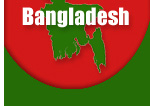Physical Overview
Most of
the areas of Bangladesh lies
within the broad delta formed by the Ganges and Brahmaputra rivers. Lands are
exceedingly flat, low-lying, and subject to annual flooding. Much fertile,
alluvial soil is deposited by the floodwaters. The only significant area of
hilly terrain, constituting less than one-tenth of the nation's territory, is
the Chittagong Hill Tracts in the narrow southeastern panhandle of the country.
There, on the border with Burma, is Mowdok Mual (1003 m/3292 ft), the country's
highest peak. Small, scattered hills lie along or near the eastern and northern
borders with India. The eroded remnants of two old alluvial terraces-the
Madhupur Tract, in the north central part of the country, and The Barind,
straddling the northwestern boundary with India- attain elevations of about 30 m
(about 100 ft). The soil here is much less fertile than the annually replenished
alluvium of the surrounding floodplain.
Land
Total area: 144,000
square kilometers;
Land area: 133,910
square kilometers
Land boundaries:
4,246 km total; 193 km with Myanmar, 4,053 km with India, Coastline:
580 km.
Land distribution:
-
arable land 67%
-
forest and
woodland 16%
-
permanent crops
2%
-
meadows and
pastures 4%
-
others 11%
Rivers and Lakes
Bangladesh is a land
of rivers that crisscrossed throughout the mostly flat territories of the
country. They include hundreds of brooks and a good number of big ones. The
Ganges (Ganga) is known as the Padma below the point where it is joined by the
Jamuna River, the name given to the lowermost portion of the main channel of the
Brahmaputra. The combined stream is then called the Meghna below its confluence
with a much smaller tributary of the same name. In the dry season the numerous
deltaic distributaries that lace the terrain may be several kilometers wide as
they near the Bay of Bengal, whereas at the height of the summer monsoon season
they coalesce into an extremely broad expanse of silt-laden water. In much of
the delta, therefore, homes must be constructed on earthen platforms or
embankments high enough to remain above the level of all but the highest floods.
In non-monsoon months the exposed ground is pocked with water-filled borrow
pits, or tanks, from which the mud for the embankments was excavated. Throughout
the country there are bils, haors and lakes that meet the need of drinking,
bathing and irrigating water.
Seasons
Traditionally
Bangladeshis subdivide the year into six
seasons: Grismo (summer), Barsha (rainy), Sharat (autumn), Hemanto
(cool), Sheet (winter), and Bashonto (spring). For practical
purposes, however, three seasons are distinguishable: summer ,
rainy, and winter.
Climate
Bangladesh has a tropical monsoon-type climate, with a hot and rainy
summer and a dry winter. January is the
coolest month with temperatures averaging near 26 deg C (78 d F) and April the warmest
with temperatures from 33 to 36 deg C (91 to 96 deg F). The climate is one of the wettest in
the world. Most places receive more than 1,525 mm of rain a year,
and areas near the hills receive 5,080 mm ). Most rains occur during
the monsoon (June-September) and little in winter (November-February).
Bangladesh is subject to
devastating cyclones, originating over the Bay of Bengal, in the periods of
April to May and September to November. Often accompanied by surging waves,
these storms can cause great damage and loss of life. The cyclone of November
1970, in which about 500,000 lives were lost in Bangladesh, was one of the worst
natural disasters of the country in the 20th century.
In Dhaka the average temperature
in
January is about 19° C (about 66° F), and in May about 29° C (about 84° F).
Flora and Fauna
Chittagong Hill Tracts,
portions of the Madhupur Tract, and the Sundarbans (a great tidal mangrove
forest in the southwestern corner of the country) are principal vegetation in
Bangladesh. The wooded area amount to less than one-sixth of the total area.
Broadleaf evergreen species characterize the hilly regions, and deciduous trees,
such as acacia and banyan, are common in the drier plains areas. Commercially
valuable trees in Bangladesh include sundari (hence the name Sundarbans), gewa,
sal (mainly growing in the Madhupur Tract), and garan (in the Chittagong Hill
Tracts). Village groves inslude fruit trees (mango and jackfruit, for instance)
and date and areca (betel) palms. The country also has many varieties of bamboo.
Bangladesh is rich in
fauna, including nearly 250 indigenous species of mammals, 750 types of birds,
150 kinds of reptiles and amphibians, and 200 varieties of marine and freshwater
fish. The rhesus monkey is common, and gibbons and lemurs are also found.
The Sundarbans area is
one of the principal remaining domains of the Royal Bengal tiger, and herds of
elephants and many leopards inhabit the Chittagong Hill Tracts. Other animals
living in Bangladesh include mongoose, jackal, Bengal fox, wild boar, parakeet,
kingfisher, vulture, and swamp crocodile.
Mineral Resources
Bangladesh is not so rich
in mineral resources. The principal energy resource, natural gas, is found in
several small fields in the northeastern part. With the assistance of some foreign
especially American companies gas expedition has increased. There is a coalfield in the northwest and
large peat beds underlie most of the delta. Limestone and pottery clays are
found in the northeastern Bangladesh.
|
Bangladesh
Overview
National
Anthem
National
Flag
Constitution
Government
Capital
National
Icons
National
Media
Independence
War
History
Geography
Economy
Currency
People
Education
Art
& Culture
Language
Religion
Festivals
Transportation
Cities
Districts
Places of Interest
Websites
|


